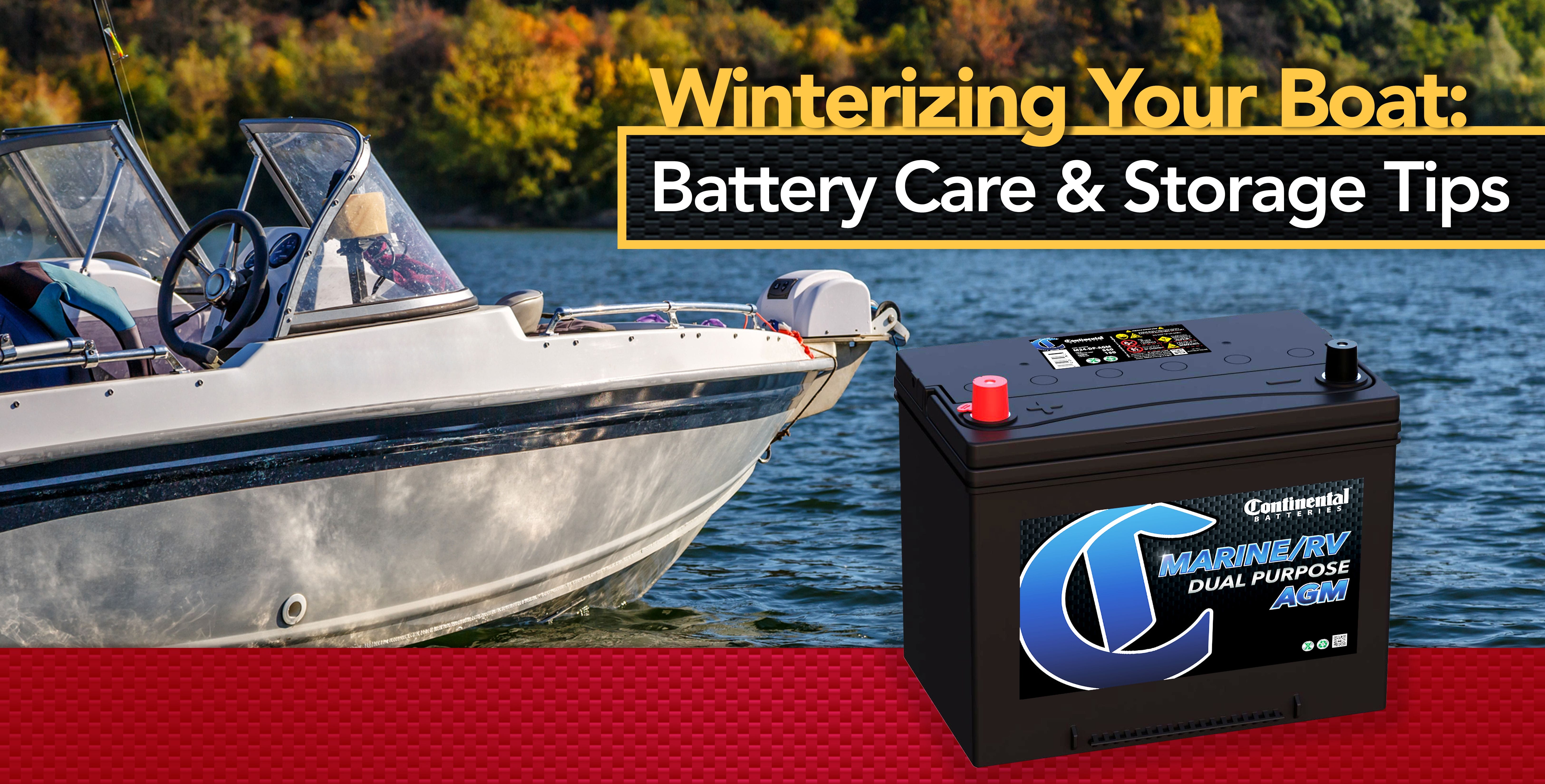
You’ve had a full and fun season out on the water, but now it’s time to pack up your boat for the colder weather ahead. Taking steps to prepare your boat battery for the off-season ensures you’ll be powered up and ready to hit the waves running when spring rolls around again.
In this guide, we will go over the ins and outs of end-of-season boat battery care, including:
- Tips for boat battery storage over winter
- The best conditions in which to store your battery
- Boat battery maintenance in the off-season
- Best practices for reinstallation when the new season rolls around
Why Proper Marine Battery Storage Is Necessary
Whether you make waves in a lake, river or ocean, your boat battery works hard all season to power your craft. When it comes time to put your boat away for the season, planning for proper charging, storage and maintenance can mean the difference between a dead boat battery and one that is ready to get back on the water come spring. Some of the risks of improper battery care include:
Freezing. If you live in a cold climate and store your boat in a garage with no temperature control, your battery may freeze over the winter. A fully charged battery may be able to weather the cold temperatures more easily, but if the battery is drained from a season of use, chances are it will freeze.
Self-discharge. All batteries naturally lose charge when not in use. The rate at which they discharge depends on the chemistry and conditions. AGM batteries, for example, discharge at a rate of about 3% per month. Lithium-ion batteries have a lower self-discharge rate, starting at about 2%. These rates go up when batteries are stored in a humid setting with temps over 80 degrees.
Parasitic draw. Self-discharge happens whether the battery is connected or not. Parasitic draw is a slow draining of a battery that has been left connected to a vehicle. Even if all onboard electronics are turned off, they will still draw a charge for your battery, depleting it over time.
Corrosion and sulfation. Marine batteries are naturally exposed to moisture and, in some cases, salt air and water, making them more susceptible to corrosion. Corrosion is more likely to develop when a battery is stored improperly for an extended time. Sulfation happens when batteries are left in a discharged state for too long.
If you’ve run your battery down and put it right into storage, sulfate crystals can form on the plates, which can kill the battery or severely reduce its lifespan.
How to Prepare Your Boat Battery for Storage
To get the most out of your marine battery for multiple seasons in a row, follow these smart storage guidelines.
Disconnect the battery. Leaving your battery plugged into the boat increases the risk of faster discharge and corrosion. Make sure to unplug the battery — and, ideally, store it in a separate location where dirt and debris are less likely to make their way in.
Inspect for damage or wear. Boats are high-vibration environments. Your battery may have been knocked around a bit throughout the season. Give it a thorough once-over and look for any visible damage. Check the terminals and connection points along with the battery casing. If you spot bulging or cracks, the battery likely needs to be replaced. Take it to a nearby recycling and reconditioning center to dispose of it responsibly.
Clean your battery. Just like you thoroughly clean your boat before tucking it away for the season, it’s important to give your battery a good scrub. Dirt, debris and corrosion can build up and cause problems if left in place for too long. Clean the boat battery with a baking soda and water solution in the same way you would clean your car battery. Check out this video for step-by-step instructions.
Test and charge the battery. Starting out on a full charge gives your battery the best chance at weathering the winter. A partially charged battery is more likely to die when left alone for months at a time. Test your battery’s charge and then charge it up before storing.

Boat Battery Charging Do’s and Don'ts
DO use the right charger for your battery type (AGM, FLA, or Lithium-ion).
DO charge to the recommended voltage for optimal performance.
DO use a battery maintainer or trickle charger.
DO follow the manufacturer’s instructions when charging any battery.
DON’T overcharge, which can lead to reduced lifespan.
DON’T use a damaged charger or one that’s not the right fit for your battery.
DON’T charge in extreme hot or cold temperatures.
DON’T rush it. Allow the battery to charge fully at the correct rate.
Finding the Right Storage Conditions
If you live in a temperate climate and plan to store your boat in an enclosed location, you may be able to store your battery inside the boat (disconnected, of course). Ideally, though, you’ll find a well-ventilated space where your battery can stay clean, dry and properly charged.
- Keep them dry. Batteries dislike humidity; keep them away from condensation.
- Keep them cool. Temperature extremes aren’t good for battery health. Store batteries in a cool place where they won’t overheat or freeze. Shoot for above 32°F and below 80°F.
- Keep them accessible. If you aren’t using a battery maintainer, you’ll want to be able to access it for testing and charging.
- Keep them organized. If your boat runs on multiple batteries, keep them organized by labeling with the battery number and storing with their corresponding cables.
Maintenance During Storage
The amount of active maintenance on your stored battery depends to some extent on the type of battery you have. Lithium-ion batteries require very little maintenance, and AGM batteries are also mostly maintenance-free. Conventional lead-acid batteries are more susceptible to sulfation and may need more frequent maintenance in the off-season.
A battery maintainer or trickle charger can make the off-season charging process easy. Once connected, the battery will stay at an optimal charge level without the risk of overcharging. Always follow the manufacturer's instructions.
Reinstallation Checklist for Next Season
When the weather warms and it is time to take your marine battery out of storage, follow this checklist for a quick and safe reinstallation:
- Inspect batteries for any signs of damage or wear.
- Clean as needed.
- Retest batteries.
- Charge batteries fully.
- Connect batteries to the boat, making sure to tie it down securely.
- Hit the water!
Proper off-season storage ensures you’ll get the most life possible out of your boat batteries. When it’s time to replace your batteries or for more tips on caring for marine and other vehicle batteries, come to your nearest Continental Battery Systems retailer.







